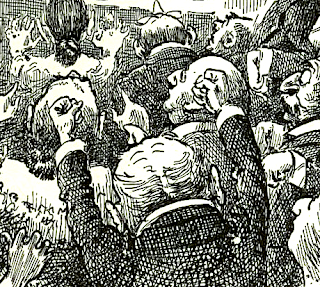THERE ARE, as perhaps the reader knows, two different ways of drawing for wood. One is, to paint a finished picture in black and white, using the brush and washes of different degrees of intensity; picking out the lights with white, or leaving the white paper for them. The [wood] engraver translates this in his own way, cutting his own lines to represent or, rather, interpret the value of the tone left by the artist. In this case the artist is very much at the mercy of his engraver.
[…]
THE OTHER way is to draw one’s picture with pencil, or, better still, with pen and ink [on wood], using a simple conventional black outline to give the shape and enclose the form and face; then adding more lines and pen-and-ink scratches, simple or cross-hatched, to suggest colour and tone, as an etcher does with his needle, and leaving blank all that the artist judges non-essential to his picture — leaving it in fact, to the imagination. The engraver cuts all this in facsimile; it is more than his place is worth to add a line of his own, or leave out one of the artist’s.
[…]
THE OTHER way is to draw one’s picture with pencil, or, better still, with pen and ink [on wood], using a simple conventional black outline to give the shape and enclose the form and face; then adding more lines and pen-and-ink scratches, simple or cross-hatched, to suggest colour and tone, as an etcher does with his needle, and leaving blank all that the artist judges non-essential to his picture — leaving it in fact, to the imagination. The engraver cuts all this in facsimile; it is more than his place is worth to add a line of his own, or leave out one of the artist’s.
[…]
I confess that, to me, the second is the more attractive of the two.
I confess that, to me, the second is the more attractive of the two.
❉
THE LOST CHORD
by George du Maurier
❉❦❉
in The Christmas Number of Punch
and Punch’s Almanack for 1894.
 |
| [1 to 4] |
 |
| [5 to 8] |
 |
| [9 to 12] |
 |
| [13 to 16] |














No comments:
Post a Comment